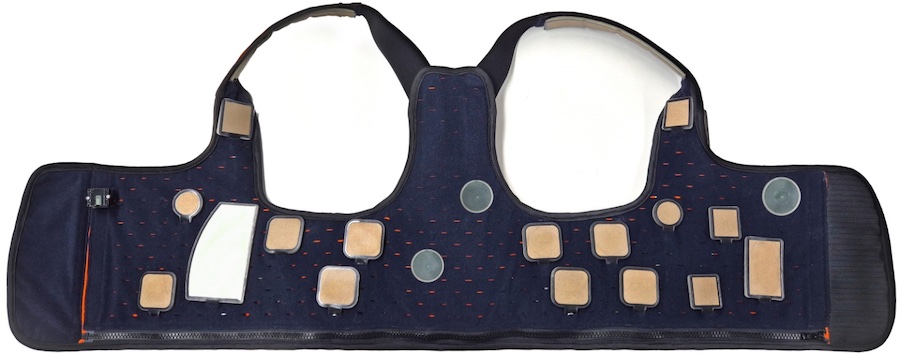#Research & Development
Catching heart disease early with AI-based sensor system

Cardiovascular diseases cause a large proportion of deaths worldwide. If they are detected in time, the chances of successful treatment are good. But long waiting lists or simply long distances for patients to see cardiac specialists often prevent an early diagnosis. Even for patients in the system, a cardiovascular problem means long and detailed analyses and regular visits to their doctor, in a local clinic or at a hospital.
As part of the joint Fraunhofer project „Medical Artificial Intelligence Applications - Center for Applied AI in Medicine“ (maia), the Fraunhofer Institute for Reliability and Microintegration IZM has teamed up with the Charité University Hospital and the Technical University of Berlin to create a sensor system that can monitor cardiovascular health in a gentle, non-invasive way.
The hardware is integrated into a smart textile vest that the patient can easily slip on and that can even be laundered. Inside the vest, there are sensors picking up more than 110 parameters, with a thousand measurements each taken every second. This makes the vest the world’s first system to capture such a large range of diagnostic parameters at the same time, and all of that continuously. On top of this information, a chatbot is at hand to ask the patient about any symptoms or issues they may be experiencing.
AI support for diagnostics and medical risk assessments
The platform is supported by a mobile edge computing module that processes the signals locally and can transmit the data wirelessly. The newly developed hybrid analytical framework combines conventional methods for processing sensor signals with cutting-edge machine learning to level up the quality of the resulting data.
The sensor data, the patient’s statements, and the doctor’s assessment are used by the AI-based system to form not just a likely diagnosis for medical personnel, but also a risk assessment for the patient, based on real-time information. This can give everybody involved crucial support for managing the cardiovascular health of the patient. It will improve access to telemedical support for patients who live in rural areas or who have mobility restrictions.
Data is captured by way of several non-invasive methods, including bioimpedance spectroscopy (BIS), electrocardiography (ECG), seismocardiography (SCG), phonocardiography (PCG), and photoplethysmography (PPG). Additional sensors are planned for the system in the future, adding echo cardiography and other capabilities. The readings are used to calculate relevant medical indicators, such as blood pressure or the size of potential edemas.
Reliable sensors in a comfortable package
The system uses innovative multichannel smart textile electrodes. To make sure that these work reliable and stay comfortable for the wearer, they come in a biocompatible and semidry form, eliminating the need for a conductive gel that could irritate and dry out the patient’s skin. The wearer simply slips on the vest, and its modular design helps keep the electrodes in the right place for stable signals, whatever shape and size the patient.
The vision is to integrate the entire system in a set of reusable stick-on patches. Made from polyurethane, the thin and dermatologically friendly material will make the system even more comfortable to wear, restrict people suffering from cardiac problems less, and ensure uninterrupted monitoring at the same time.
Fraunhofer IZM will be showcasing the system at Compamed 2025, the leading medical technology expo, coming to Düsseldorf between 17 and 20 November.













